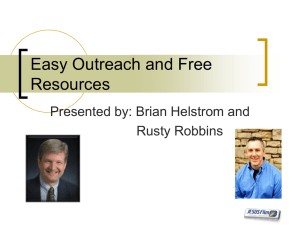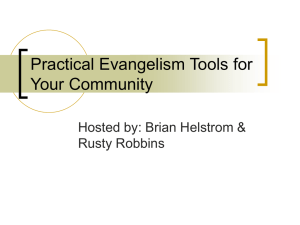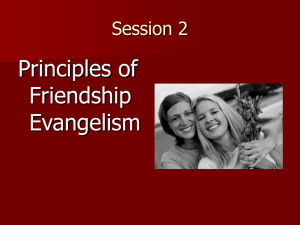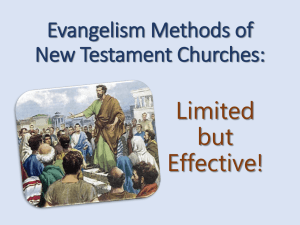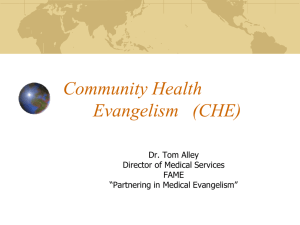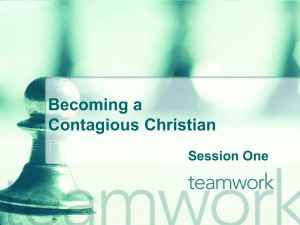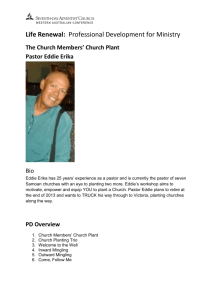dis744_syllabus_2012_currah
advertisement
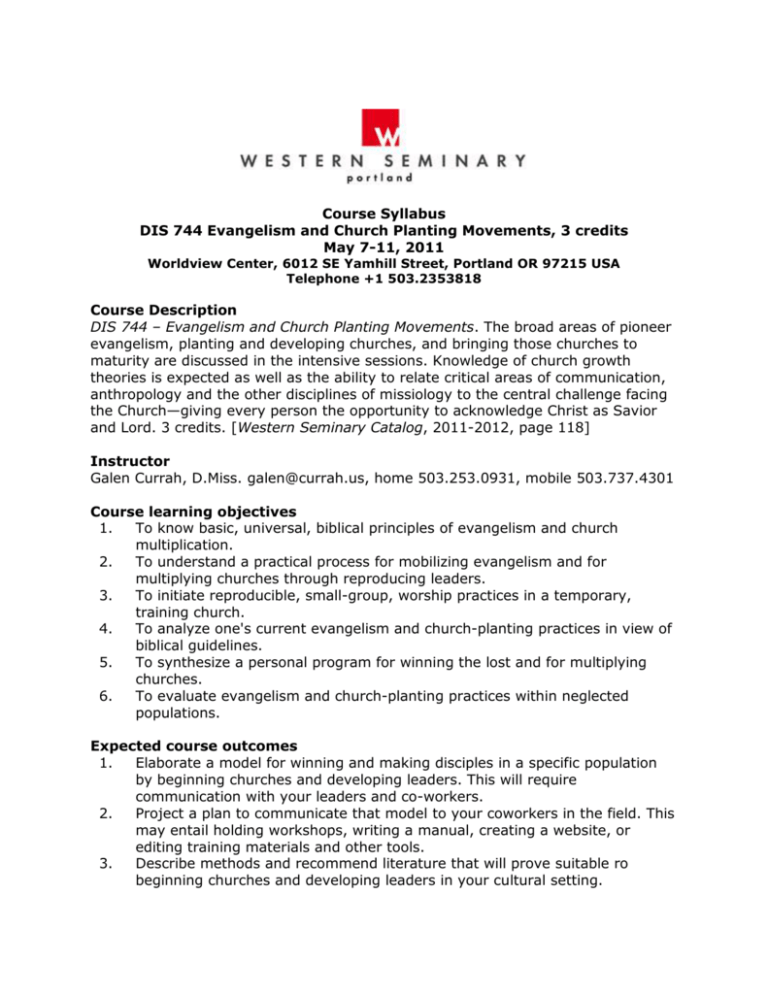
Course Syllabus DIS 744 Evangelism and Church Planting Movements, 3 credits May 7-11, 2011 Worldview Center, 6012 SE Yamhill Street, Portland OR 97215 USA Telephone +1 503.2353818 Course Description DIS 744 – Evangelism and Church Planting Movements. The broad areas of pioneer evangelism, planting and developing churches, and bringing those churches to maturity are discussed in the intensive sessions. Knowledge of church growth theories is expected as well as the ability to relate critical areas of communication, anthropology and the other disciplines of missiology to the central challenge facing the Church—giving every person the opportunity to acknowledge Christ as Savior and Lord. 3 credits. [Western Seminary Catalog, 2011-2012, page 118] Instructor Galen Currah, D.Miss. galen@currah.us, home 503.253.0931, mobile 503.737.4301 Course learning objectives 1. To know basic, universal, biblical principles of evangelism and church multiplication. 2. To understand a practical process for mobilizing evangelism and for multiplying churches through reproducing leaders. 3. To initiate reproducible, small-group, worship practices in a temporary, training church. 4. To analyze one's current evangelism and church-planting practices in view of biblical guidelines. 5. To synthesize a personal program for winning the lost and for multiplying churches. 6. To evaluate evangelism and church-planting practices within neglected populations. Expected course outcomes 1. Elaborate a model for winning and making disciples in a specific population by beginning churches and developing leaders. This will require communication with your leaders and co-workers. 2. Project a plan to communicate that model to your coworkers in the field. This may entail holding workshops, writing a manual, creating a website, or editing training materials and other tools. 3. Describe methods and recommend literature that will prove suitable ro beginning churches and developing leaders in your cultural setting. DIS 744 Evangelism and Church Planting Movements, May, 2012 Course preparation 1. Read for a minimum of 1500 pages related to the course objectives, including the recommended readings (see below). If you have already read the recommended works, then read from other such works. Try to complete the reading prior to the course. Write a one-page reading report on each work, summarizing its most salient points. Reading reports are due by the first day of the course and may be sent early via electronic mail. 2. Draft up a summary of the Original, Apostolic Good News, from your own exegesis of these biblical texts or others like them, in their context: (a) Luke 24:44-49; (b) Acts 2:22-25 & 32-38; (c) 3:13-15, 18-19, 26; (d) 5:29-32; (e) 10:38-43; (f) 13:28-33, 37-38; (g) 17:1-3; (h) 17:29-31; (i) 26:18-23; (j) Romans 1:1-7; 1 Corinthians 15:1-8. Course involvement 1. The course participants will form one or more temporary little cell group or churches that will practice some of the commandments of Jesus as the early churches did. This will include worship, prophecy, sharing, holy communion and prayers, done in a simple way that others could imitate easily. 2. Course participants are encouraged to share their thoughts freely, to raise questions, to challenge ideas, to share about experiences, to make recommendations, to generate new ideas, and to kibitz wildly. 3. Last day the course, each participant will make a presentation of their current evangelism, church-planting and leader-training practices, with an analysis of hindrances to the same, making recommendations for the near future. The other course participants will discuss your ideas and raise questions, drawing on principles and practices gleaned from their experience, from their reading and from this course. Course requirement By the end of the summer term, you will submit a paper to the instructors which (a) describes a model for evangelism and reproductive church planting in your field or ministry, (b) recommending methods suitable to the culture group(s) you work with. This paper must follow Western Seminary and DIS academic form and standards, including an introduction, several main sections, a conclusion and bibliography of works cited and consulted. You may download guidelines and templates from http://currah.info/pages/format Course topics Course discussion will include, but may not be limited to, the following topics: The original, apostolic Good News, the power of God for salvation Apostolic, historical and contemporary practices that foster CPMs Soul-winning and church planting as an integral subsystem of ministry Cultural variables within evangelism and church planting efforts Definitions of church planting movements (CPM) Envisioning, praying, planning, implementing, monitoring & evaluating CPMs Mentored, generational training of evangelists, leaders and church planters Monitoring and research methods for church planting movements 2 DIS 744 Evangelism and Church Planting Movements, May, 2012 Recommended reading If you have read any of these works, then read some other work on evangelism and church planting for multiplication. Some of these titles may be read on-line at http://www.google.com/books. Other materials will be posted for download at http://currah.info/pages/dis744 1999 Neumann, Mikel Home Groups for Urban Cultures; Pasadena: William Carey. ISBN 0-87808-281-6. 2001Patterson, George and Galen Currah Disciple the Nations, an interactive e-textbook written in the form of a novel (software); download free from http://www.paul-timothy.net/dn/ 2002 Patterson, George and Richard Scoggins Church Multiplication Guide (revised edition); Pasadena: William Carey; ISBN 9780878084470 2004 Garrison, David Church Planting Movements: How God is Redeeming a Lost World, Midlothian VA: WIGTake Resources (see: www.churchplantingmovements.com); ISBN 0-9747562-0-2 2006 Schwarz, Christian A. Natural Church Development; A Guide to Eight Essential Qualities of Healthy Churches (revised), Carol Stream IL: ChurchSmart Resources. ISBN 1-889638-00-5 2007 O’Connor, Patrick Reproducible Pastoral Training: Church Planting Guidelines from the Teachings of George Patterson; Pasadena: William Carey; ISBN 9780878083671 2007 Zdero, Rad, ed. Nexus: The world house church movement reader, Pasadena: William Carey; ISBN 087808374X 2009 Dale, Tony and Felicity, and George Barna The Rabbit and the Elephant: Why small is the new big for today’s church; Carol Stream IL: Barna/Tyndale House; ISBN 9-7814-325538 2010 Cole, Neil Church 3.0: Upgrades for the future of the church. San Francisco: Jossey-Bass; ISBN 978-0-470-58456-9 2011 Smith, Steve with Ying Kai. T4T: A Discipleship Re-Revolution; Monument, Colorado: WIGTake; ISBN 97809747562-1-9. Western Seminary Disability Statement Western Seminary is committed to responding to the needs of students with disabilities as outlined in both the Rehabilitation Act of 1973 and the Americans with Disabilities Act of 1990. Western students are assisted individually as their needs dictate. It is the responsibility of students with disabilities to identify themselves and the nature of the disability. Any student who has a disability should contact the seminary’s Disability (Section 504) Coordinator, Ken Epp, at 503-517-1815 or 1-877-517-1800, ext. 1815. 3
